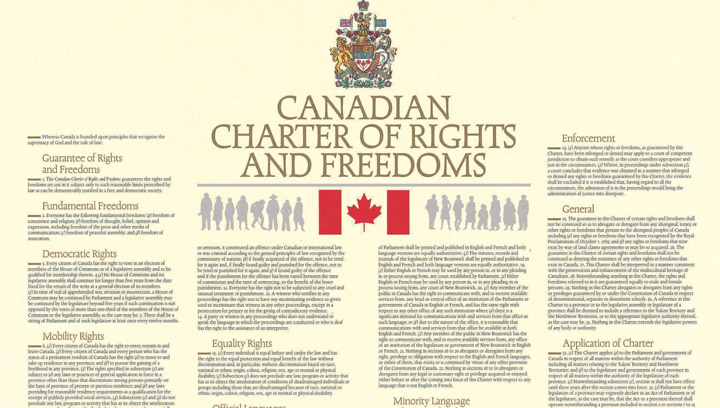SASKATOON – On Jan. 30, the Supreme Court of Canada struck down parts of Saskatchewan’s Essential Service Act, saying there is a right-to-strike under the Charter of Rights and Freedoms.

On Wednesday, Saskatchewan Premier Brad Wall suggested he would look at invoking the Charter’s notwithstanding clause if an agreement could not be worked out on amending the essential service legislation, which the court gave the province one year to do.
READ MORE: Wall open to overiding Supreme Court labour ruling
So what is the Charter’s notwithstanding clause?
Under section 33, parliament and provincial legislatures can override the fundamental freedoms, equality and legal rights that are entrenched in the Charter for a period of no more than five years. Here is the exact wording:
(1) Parliament or the legislature of a province may expressly declare in an Act of Parliament or of the legislature, as the case may be, that the Act or a provision thereof shall operate notwithstanding a provision included in section 2 or sections 7 to 15.
(2) An Act or a provision of an Act in respect of which a declaration made under this section is in effect shall have such operation as it would have but for the provision of this Charter referred to in the declaration.
(3) A declaration made under subsection (1) shall cease to have effect five years after it comes into force or on such earlier date as may be specified in the declaration.
- Canadian man dies during Texas Ironman event. His widow wants answers as to why
- On the ‘frontline’: Toronto-area residents hiring security firms to fight auto theft
- Honda’s $15B Ontario EV plant marks ‘historic day,’ Trudeau says
- Canadians more likely to eat food past best-before date. What are the risks?
(4) Parliament or the legislature of a province may re-enact a declaration made under subsection (1).
(5) Subsection (3) applies in respect of a re-enactment made under subsection (4).
How did the “notwithstanding clause” come to be?
Although there are differing opinions, the notwithstanding clause came about following a meeting in 1981 between the justice minister Jean Chrétien and Roy Romanow and Roy McMurtry, the attorney general’s of Saskatchewan and Ontario.
The trio met on the night of Nov. 4 after the first ministers constitutional conference being held at the time appeared to be at a stalemate.
Chrétien, Romanow and McMurtry worked out a compromise which was then drafted by officials without the participation of anyone from Quebec. The result was the “notwithstanding clause” along with the constitution’s amending formula.
Without the notwithstanding clause, Chrétien would later say, “Canada probably wouldn’t have had any Charter.”
Who has used the notwithstanding clause?
Only three provinces – Quebec, Saskatchewan and Alberta – and the Yukon have used the notwithstanding clause.
Although Quebec never agreed to the constitutional accord, the notwithstanding clause wording was placed into every piece of legislation passed by the National Assembly between 1982 and 1985. It also enacted legislation to amend every Quebec law in place at the time to be amended with the notwithstanding clause. The practice ceased in 1987 when a new liberal provincial government was elected.
Quebec also used the clause in 1988 after the Supreme Court found a law prohibiting the use of any language other than French on outdoor commercial signs violated freedom of expression. It was the first time the notwithstanding clause had been used in response to a high court ruling. The Quebec government did not re-enact it when it lapsed five years later.
Saskatchewan used the notwithstanding clause in 1986 after the Saskatchewan Court of Appeal ruled the province’s back to work legislation violated freedom of association. The Supreme Court of Canada later found the law to be consistent with the Charter stating, interestingly enough at that time, that the Charter “does not include a guarantee of the right to bargain collectively and the right to strike.”
In Alberta, a private members bill passed in 2000 amending the province’s Marriage Act to define marriage as heterosexual couples only, which also included the notwithstanding clause. The Supreme Court later ruled that the definition of marriage was the exclusive domain of parliament.
The Yukon was the first Canadian jurisdiction to use section 33. It was part of the territory’s Land Planning and Development Act, which, although assented to, was never proclaimed into force.


Comments